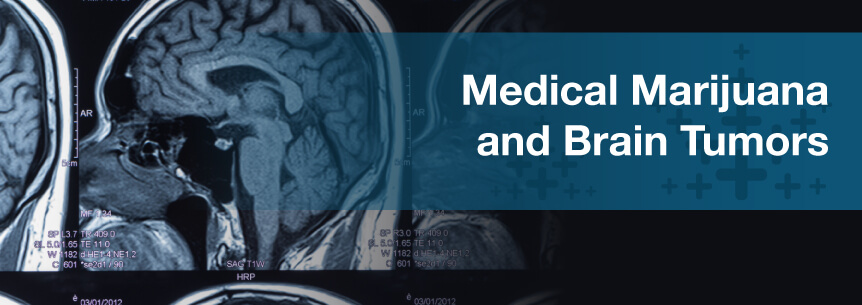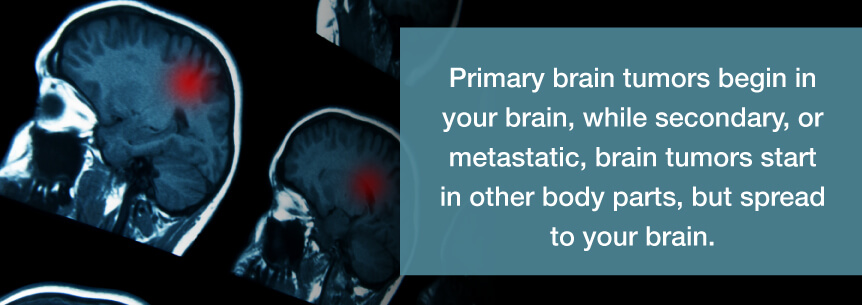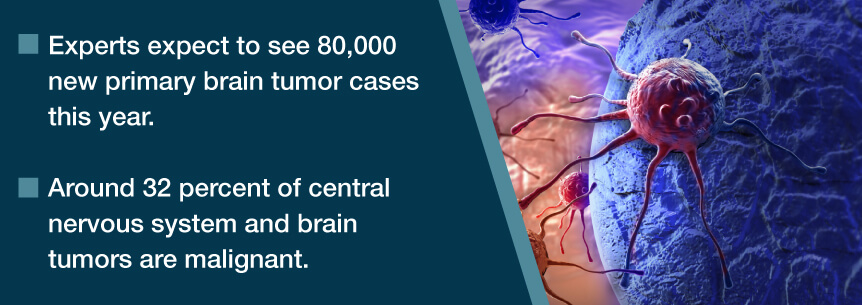
Despite the many, constant advancements in cancer medicine, there still isn’t any proven cure for the disease as of yet. However, medical marijuana and brain tumors treatment is stepping up and joining hands with conventional treatments to offer patients some relief from the sometimes disabling effects of radiation, chemo and other unfavorable treatment methods.
Brain tumors are growths or masses of abnormal brain cells.
The rate at which a brain tumor grows will vary. How it develops, as well as where it’s located, determine how it affects your nervous system function.
The exact cause of brain tumors remains unknown, but researchers have established some known risk factors. For example, kids who receive head radiation have a greater risk of adult brain tumor development later on.
Also, those with Li-Fraumeni syndrome, neurofibromatosis or another rare genetic condition have a higher risk. But, these cases make up only a mere fraction of the estimated 78,980 new diagnosed brain tumors every year in the U.S., according to the National Brain Tumor Society.
Many different brain tumor types exist. Some are benign, while others are malignant. Primary brain tumors begin in your brain, while secondary, or metastatic, brain tumors start in other body parts, but spread to your brain.

Physicians refer to tumors based on if they’re malignant or benign and where the tumor cells started. Let’s take a closer look.
Benign brain tumors are the least aggressive type of tumors in the brain. They:
Malignant brain tumors do have cancer cells and typically don’t have clear borders. They can be life-threatening, since they quickly grow and attack surrounding brain tissue.
These tumors begin in your brain cells. They might spread to your spine or other brain parts, but don’t usually spread to your other organs.
Also called secondary brain tumors, metastatic tumors start in other parts of your body before spreading to your brain. They’re named after the area where they started, and are more common than the primary brain tumors.
According to the National Brain Tumor Society, more than 120 different brain tumor types exist. Below are five common types.
Cancer isn’t a new disease. In fact, evidence of tumors has occurred in Egyptian mummies and fossilized bones. Throughout history, even way back in 3000 BCE, people have been noting cancer occurrences. Ancient surgical manuscripts report eight breast cancer cases stating there’s no treatment. Since then, people have learned a lot about cancer and have made outstanding advances to treat patients. For many cancers today, the outlook isn’t so bleak.
The symptoms and signs of brain tumors depend on their location, size and growth rate. Brain tumor symptoms can be specific or general. Tumor pressure on the spinal cord or brain causes general symptoms. And, when the tumor causes a certain area of your brain not to work well, it causes specific symptoms. Many individuals with a brain tumor received their diagnoses after visiting their doctor complaining of some problems like balance issues, headaches or other types of changes.
The general symptoms brain tumors cause may include:
If you experience symptoms persistently concerning to you, schedule an appointment with your physician.
Your brain controls all of your body functions, including hearing, vision, movement and speech. As cancer in your brain grows, it begins to press on and damage areas in your brain that control these things, which may lead to both physical and mental complications such as:
Younger patients frequently experience the late effects of their treatment for brain cancer throughout their childhood. For pediatric ependymoma survivors, along with the complications previously listed, these neurological symptoms and late effects may include:
You may also struggle with diagnosis and treatment stress-related emotional problems.
According to the American Brain Tumor Association, brain tumor statistics as of January 2018 include:

Your treatment options for a brain tumor will depend on what type and size of tumor you have and its location.
Sometimes, a tumor is so easy and small to separate from the neighboring brain tissue, it makes the option of surgery possible. In other situations, the surgeon can’t separate the tumor from the neighboring tissue, or the tumor sits next to sensitive brain areas, making surgery risky. When this occurs, the surgeon will try and eliminate as much of your tumor as they safely can.
The surgeon can reduce your symptoms by eliminating only a small part of your tumor. No matter what, though, surgery for removing any brain tumor does come with risks like bleeding and infection. Other risks will depend on the area of the brain where your tumor sits. For example, if your tumor is close to the nerves connecting your eyes, the surgery could come with the risk of vision loss.
In some cases, the surgeon can’t surgically remove a tumor due to its location in your brain. In these cases, you may require radiation therapy or chemotherapy to shrink or kill the tumor. Sometimes, the surgeon may use radiation or chemo after your surgery to kill any cancer cells remaining. If your tumor is deep in your brain or hard for the surgeon to access, the doctor may use an extremely focused radiation treatment known as gamma knife therapy.

Targeted drug therapy involves treatments to target specific irregularities in your cancer cells. When targeted drug treatments block the irregularities, they may induce cancer cell death.
Targeted therapy medications are available for specific brain tumor types, and more clinical trials are including more of these drugs to study. Various types of targeted therapy continue to pop up.
Your doctor may recommend rehabilitation after your treatment. Recovery may involve you working closely with a few different therapists like:
Since a brain tumor develops in your brain parts controlling speech, motor skills, thinking and vision, rehabilitation could be an important part of your recovery.
There hasn’t been much research on alternative and complementary treatments for brain tumors. There aren’t any alternative treatments shown to cure a brain tumor, either. However, complementary treatments could help you deal and cope better with brain tumor diagnosis-related stress.
Some complementary therapies you could try to help you cope include:
Discuss your options with your doctor.
Studies show cannabinoids such as THC have anti-cancer properties. In 2009, Spanish researchers found THC induced brain cancer cell death, or autophagy, a normal physiological process dealing with body cell destruction.
After researchers administered THC to mice models with human tumors, the THC seemed to initiate autophagy and resulted in a decrease in tumor growth. Two human brain tumor patients whose tumors were highly aggressive received intracranial THC administration. Upon analysis, both showed similar autophagy signs. The research confirmed — medical marijuana kills brain tumors, not your healthy brain tissue.
So, how does it do this? It seems THC works in two ways to kill glioblastoma cells. Along with other cannabinoids, it cuts off the blood supply to the tumor and causes the cancerous cells to self-destruct.
Researchers in 2004 found medical weed changes genes creating the Vascular Endothelial Growth Factor (VEGF) compound, which helps with the growth of new blood vessels. As the cancer cells begin growing larger, they start developing blood vessels.
The researchers treated both the two human patients with brain cancer and the mice with cannabinoid medications. VEGF decreased in both models and limited the blood supply to the tumor.
Another huge discovery concerning medical marijuana for brain tumors was that cannabinoids can also kill cancerous cells. The herb’s compounds prevent existing tumors from growing by cutting off their supply of blood, starving them and eventually causing the self-destruction of the cancer cells. Scientists refer to this self-destruction as “programmed cell death.”
Not only can marijuana and brain tumors treatment help treat brain cancer itself through the ways mentioned above, but it’s particularly useful in treating the side effects of certain cancer treatments. Some treatment side effects may include:
There are plenty more, but these are just some of the common side effects of treatments for cancer weed can help.
Cancer is a heavily researched and complex medical disease that still has limited answers and no official cure. However, today, various medical pot studies worldwide have found a wide range of therapeutic and healing benefits of medical cannabis for brain tumors, particularly helping with some conventional cancer treatment symptoms.

Because of this, budtenders all over the world are creating different strains to come up with a wide range of medicinal strains for patients with cancer or any other type of medical condition. Some good marijuana and brain tumor strains to try include:
Pain
Nausea
Loss of Appetite
Depression
Fatigue
Even though medical weed can help decrease symptoms of various health conditions, it can also produce undesirable effects if misused. Like with tobacco and alcohol, there’s no “safe” amount of cannabis use in women who are breastfeeding or pregnant.
Therefore, before beginning your medical marijuana and brain tumors treatment, consult with your cannabis doctor about your particular situation to ensure cannabis is right for you and to give you some helpful advice. With this in mind, here are some popular delivery methods for your medical pot therapy.
Experiment a little and see which cannabis and brain tumors method is right for you.
So, you’re well-educated on the benefits of medical pot as your brain tumor treatment. Now, all you need to do is talk with a marijuana doctor to get the required recommendation and marijuana card. Then, you can start browsing through our cannabis directory and find some local dispensaries to get your herb promptly.
Find A Doctor Find A Dispensary